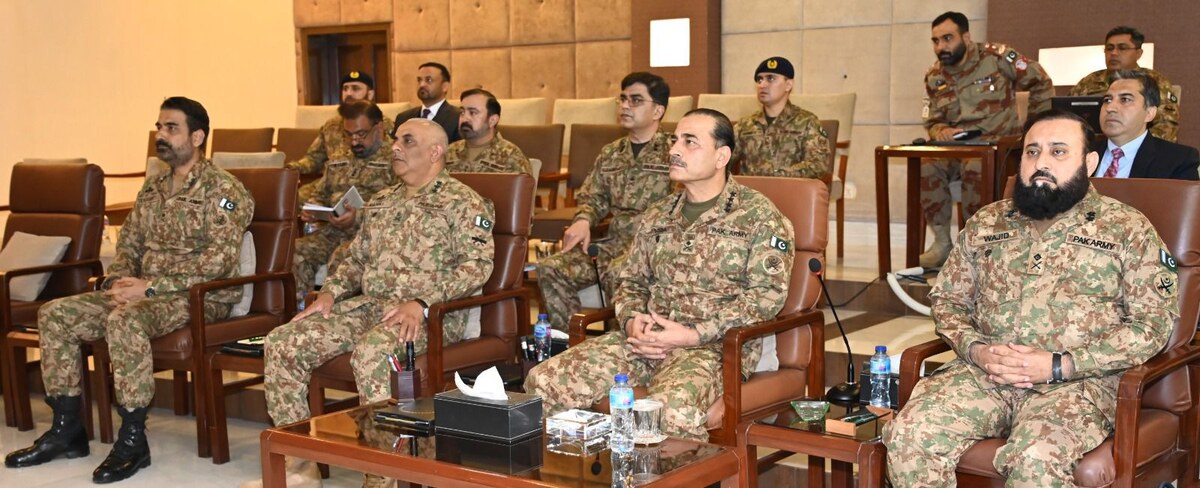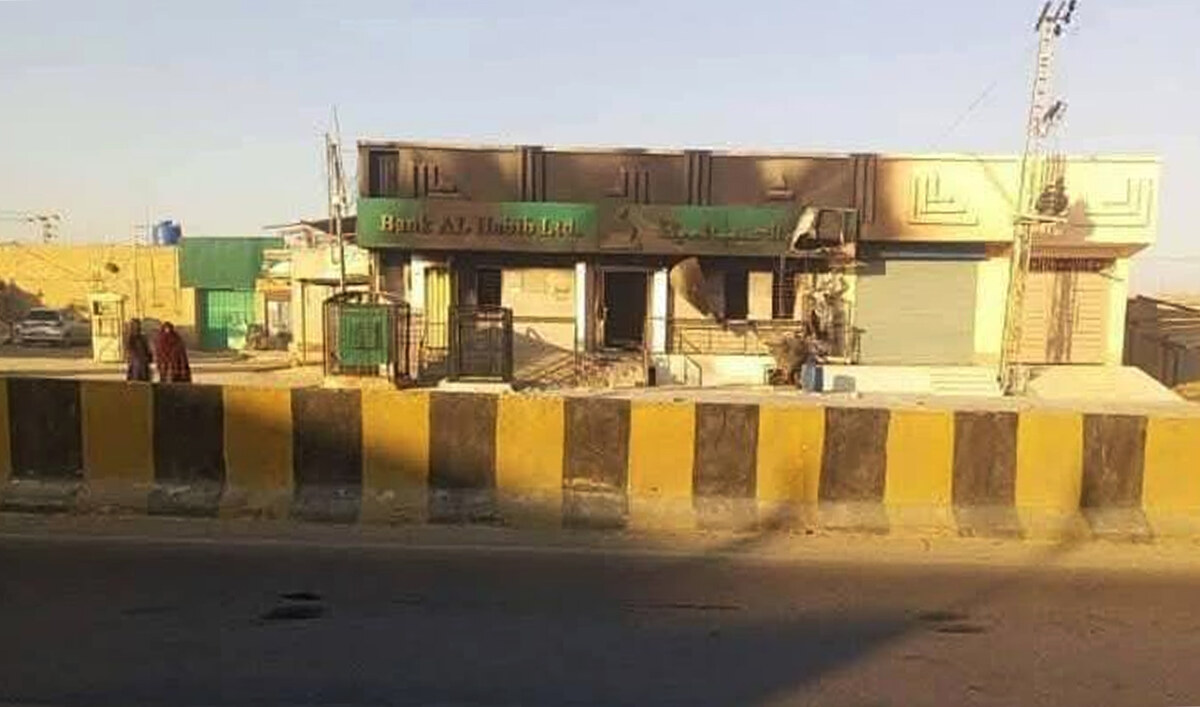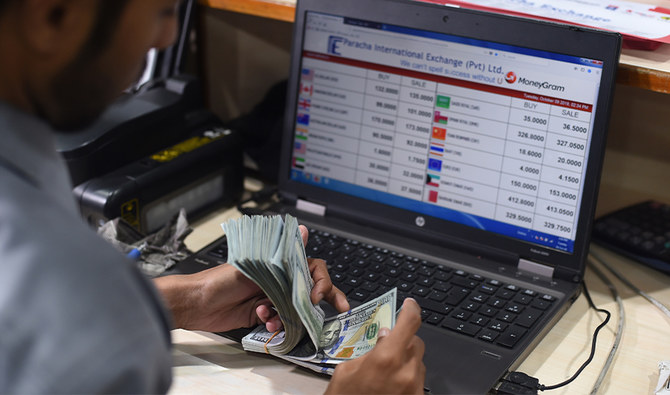KARACHI: Afghanistan’s emerging situation and burgeoning import bills are keeping Pakistan’s currency under pressure which has depreciated by more than 10 percent in the last four months, said traders and analysts on Friday.
The Pak rupee did make some progress in the last two days and closed at Rs166.91 on Friday. Official data reveal the currency was hovering around the same level last year on July 29 when the country was witnessing the peak of the coronavirus pandemic.
“The situation in Afghanistan is keeping the national currency under tremendous pressure,” said Khurram Schehzad of Alpha Beta Core, a financial advisory platform. “Greenback is in a massive demand in Afghanistan since the withdrawal of the international forces.”
Local currency dealers agree with the assessment, saying about $2 million have been flowing out of the country to Afghanistan on a daily basis since the fall of Kabul.
“Afghans with dual nationality have been buying 1.5 to 2 million dollars on a daily basis from open market and taking it to their country since the American currency is now in a short supply over there,” Malik Bostan, Chairman Forex Association of Pakistan, told Arab News. “The inflow of dollars has stopped in the neighboring country, and Afghanistan's entire banking system has collapsed.”
“Previously, Pakistan received $5 million to $7 million from Afghanistan every day since currency was cheap over there and salary payments were mostly made in dollars,” he added.
Apart from the situation in Afghanistan, the Pakistani rupee is also weakening against greenback due to the country’s growing trade deficit.
Pakistan has recorded the highest trade deficit in August when its import bill stood at $6.3 billion and its export revenue was $2.25 billion, causing a trade deficit of $4.06 billion. Previously, the country had recorded its highest deficit of $3.77 billion in June 2018.
“The situation indicates that dollar is in a short supply to meet the demand of importers which is exerts a significant pressure on the national currency,” Samiullah Tariq, director research at the Pakistan-Kuwait Investment, told Arab News.
“In July, the current account deficit was $773 million, but it seems that it is going to be higher for August, though the remittance figures have yet not been released,” he added.
The State Bank of Pakistan reported on Thursday the country had $27.22 billion in foreign reserves. The country’s forex position was also strengthened since it received $2.75 billion from the International Monetary Fund (IMF) last week. However, this build-up has also failed to cool the currency market where the Pakistani rupee remains under pressure.
“The policy of the government or the central bank seems to be that it is not going to use its forex reserves to defend the rupee,” Tariq commented.
US withdrawal from Afghanistan, high import bill weaken Pakistan’s currency — traders
https://arab.news/c6y5n
US withdrawal from Afghanistan, high import bill weaken Pakistan’s currency — traders

- Local currency dealers say nearly $2 million have been flowing to Afghanistan from Pakistan on a daily basis since the international military pullout
- The Pakistani currency has lost nearly 10 percent of its value against the US dollar in the last four months
Pakistan president approves judges’ transfer to Islamabad High Court amid judiciary row

- News reports say government aims to appoint one of the transferred judges as Islamabad High Court’s chief justice
- Islamabad Bar Council criticizes move as “affront to the independence of the judiciary,” undermines rights of legal fraternity
ISLAMABAD: Pakistan’s President Asif Ali Zardari this week approved the transfer of three judges from the high courts of Sindh, Balochistan and Lahore to the Islamabad High Court (IHC), despite opposition from five IHC judges who had warned that the decision would not be in line with the constitution.
As per a notification from the Ministry of Law and Justice on Saturday, Zardari approved the transfers of Justice Sardar Muhammad Sarfraz Dogar from the Lahore High Court (LHC), the Sindh High Court’s (SHC) Justice Khadim Hussain Soomro and the Balochistan High Court’s (BHC) Justice Muhammad Asif to the IHC.
Local media reports had stated the government was considering transferring Justice Dogar as it wanted to elevate him to the post of IHC chief justice. Reports said incumbent IHC Chief Justice Aamer Farooq is expected to be elevated to the Supreme Court.
Five of the 10 IHC judges formally opposed Justice Dogar’s transfer on Friday. In a letter addressed to the chief justices of the Supreme Court, IHC, LHC and SHC, the judges said that if the decision to transfer the judge was to consider him as IHC chief justice, it would be “fraud on the constitution.”
In a notification released on Saturday, the Ministry of Law and Justice announced:
“In exercise of the powers conferred under clause I of Article 200 of the Constitution of the Islamic Republic of Pakistan, the President of the Islamic Republic of Pakistan is pleased to transfer:
Mr. Justice Sardar Muhammad Sarfraz Dogar, judge from the Lahore High Court to the Islamabad High Court, Mr. Justice Khadim Hussain Soomro judge from the Sindh High Court to the Islamabad High Court and Justice Muhammad Asif judge from the Balochistan High Court to the Islamabad High Court.”
Pakistan’s constitution empowers the president to transfer a judge from one high court to another after the concerned judge consents to the decision. The president can approve the transfer after consulting the chief justice of Pakistan and the chief justice of both high courts.
The Islamabad Bar Council unanimously rejected the president’s decision in a statement on Saturday.
“This decision is an affront to the independence of the judiciary and undermines the rights and representation of the legal fraternity in Islamabad,” the council wrote in a press release.
The council said it has convened an Emergent General House Session at 11:00 am on Sunday, along with the Cabinets of the Islamabad High Court Bar Association and the Islamabad District Bar Association, to deliberate on the “future course of action.”
“The Islamabad Bar Council urges the legal fraternity to unite in this critical time to uphold the sanctity of the judiciary and protect the interests of the Islamabad’s legal practitioners,” it added.
Pakistan’s FIA says key facilitator of Morocco boat tragedy arrested

- Several Pakistanis were on board migrant ship that sank off Morocco’s coast this month
- FIA says suspect Abdul Ghaffar involved in human smuggling in Mauritania, Burkina Faso
ISLAMABAD: The Federal Investigation Agency (FIA) this week announced it had arrested a human smuggler who was the main facilitator of the Morocco boat tragedy in which several Pakistanis were killed this month.
Pakistan’s foreign office confirmed earlier this month that a migrant boat with several Pakistanis had capsized near the coast of Morocco en route to Spain. According to Moroccan authorities, 36 people were rescued from the vessel, which had departed Mauritania on Jan. 2. The boat had 86 migrants on board, including 66 Pakistanis, minority rights group Walking Borders said.
Prime Minister Shehbaz Sharif had instructed the government to take stern action against human smugglers involved in sending desperate Pakistani citizens on dangerous journeys to Europe via sea.
“The main facilitator of the Morocco boat accident, Abdul Ghaffar, was arrested at Islamabad Airport yesterday,” a statement from the FIA said on Saturday, adding that it has traced the gang of human smugglers involved in the incident.
The investigation agency said Ghaffar had been living in Mauritania since 2023 and had facilitated sending several Pakistanis to Europe. It said the accused’s father, Muhammad Sarfraz and close relative Munir Ahmed are also involved in human trafficking in Mauritania since 2018.
FIA said it had nabbed Ghaffar when he arrived in Islamabad on Friday with seven passengers. After being identified by the passengers, he was taken into custody and shifted to Faisalabad.
“Important evidence was recovered from Adul Ghaffar, the agent involved in human trafficking,” the FIA said.
The agency said it has evidence Ghaffar was in contact with an African human smuggler named Abu Bakar. It said upon initial investigation the FIA found out that Ghaffar and his accomplices were actively involved in human smuggling in the African countries of Mauritania and Burkina Faso.
“The suspects helped Pakistanis onto boats by luring them with promises of sending them to Europe, which resulted in the deaths of several Pakistanis,” the agency said.
The FIA said a case has been registered against Ghaffar and further investigations are underway. The agency said it expected more arrests after extracting information from the suspect.
“Strict legal action will be taken against smugglers who play with innocent lives,” the FIA vowed.
The Morocco boat tragedy highlighted the perilous journeys many migrants, particularly Pakistanis, undertake due to conflict and economic instability in their home country.
In 2023, hundreds of migrants, including 262 Pakistanis, drowned when an overcrowded vessel sank in international waters off the southwestern Greek town of Pylos.
It was among the deadliest boat disasters ever recorded in the Mediterranean Sea.
Pakistan anti-graft body files reference against property tycoon over illegal transfer of Karachi land

- Malik Riaz Hussain and others are accused of having over 7,000 acres of government land transferred illegally to Bahria Town Karachi
- The development comes days after National Accountability Bureau said it had initiated process to seek Hussain’s extradition from UAE
KARACHI: Pakistan’s National Accountability Bureau (NAB) has filed a reference against real estate tycoon, Malik Riaz Hussain, and 32 other individuals over illegal transfer of government lands for a mega project in the southern Pakistani city of Karachi, a NAB spokesperson said on Saturday.
Hussain, who currently lives in Dubai, is one of Pakistan’s wealthiest and most influential businessmen and the country’s largest private employers. He is best known as the chairman of M/s Bahria Town, which claims to be Asia’s largest private real estate developer and has projects in Islamabad, Lahore, Karachi and other cities.
NAB filed the reference in an accountability court in Karachi nominating Hussain, his son Ahmed Ali Riaz, former Sindh chief minister Syed Qaim Ali Shah and Sharjeel Inaam Memon, then local body minister and now information minister of Sindh, among 33 people for illegally transferring government land to M/s Bahria Town for its Bahria Town Karachi project in 2013 and 2014.
“Accused persons in connivance with each other illegally transferred the government land, initialy admeasuring 7220 acres, to M/s Bahria Town,” the anti-graft body said in the reference. “The said illegal transfer of government land to Bahria Town was made under the garb of adjustment/exchange/consolidation.”
It said the accused persons acted as an “organized syndicate” to cause cumulative losses of Rs700 billion ($2.5 billion) to the national exchequer, requesting the court to try them for committing the “offenses of corruption and corrupt practices.”
The development came days after NAB said it had initiated the process to seek Hussain’s extradition from the United Arab Emirates (UAE), who was also charged in another land corruption case involving former prime minister Imran Khan and his wife.
A Pakistani court last month sentenced Khan to 14 years in prison and his wife, Bushra, to seven years, in the case in which they are accused of receiving land as a bribe from Hussain through the Al-Qadir charitable trust in exchange for illegal favors during Khan’s premiership from 2018 to 2022. Khan says he and his wife were trustees and did not benefit from the land transaction. Hussain too denies any wrongdoing relating to the case.
“We have written to the Federal Investigation Agency for the extradition,” a NAB spokesman told Arab News on Wednesday, adding that the FIA would now pursue the case.
Prior to that, Defense Minister Khawaja Asif confirmed that Pakistan would use its extradition treaty with the UAE to bring Hussain back.
Last month, NAB also cautioned people against investing in Hussain’s new real estate venture to build luxury apartments in Dubai.
“If the general public at large invests in the stated project, their actions would be tantamount to money laundering, for which they may face criminal and legal proceedings,” it said.
Hussain responded to NAB in a post on X, saying that “fake cases, blackmailing and greed of officers” had forced him to relocate from Pakistan because he was not willing to be a “political pawn.”
Pakistani PM hopes Sharaa assuming president’s office will bring peace to Syria

- Al-Sharaa was declared president for a transitional phase on Wednesday, less than two months after he led a campaign that toppled Bashar Assad
- Sharaa said he will form an inclusive transitional government that will build institutions and run the country until it can hold free and fair elections
ISLAMABAD: Pakistan Prime Minister Shehbaz Sharif on Saturday welcomed Ahmed Al-Sharaa’s assumption of the office of the Syrian president, hoping it would lead to peace in Syria.
Sharaa was declared president for a transitional phase on Wednesday, less than two months after he led a campaign that toppled Bashar Assad.
He was also empowered to form a temporary legislative council for a transitional period and the Syrian constitution was suspended.
“We welcome Mr. Ahmed Al-Sharaa’s assumption of office as President of the Syrian Arab Republic during the transitional phase and hope that the new leadership will be able to bring peace, progress and prosperity to the brotherly people of Syria,” Sharif said on X.

On Thursday, Sharaa said he will form an inclusive transitional government representing diverse communities that will build institutions and run the country until it can hold free and fair elections.
He was addressing the nation in his first speech since being appointed president by the military command that ousted Assad in a lightning offensive last year.
The group that led the offensive, Hayat Tahrir Al-Sham, has since set up an interim government that has welcomed a steady stream of senior Western and Arab diplomatic delegations keen to help stabilize the country after 13 years of civil war.
Pakistan army chief vows retaliation after militant attack kills 18 troops in Balochistan

- Pakistani forces suffered casualties when they engaged militants who had erected barricades on a key highway in Kalat district late Friday
- Balochistan has for years been the scene of an insurgency, with several separatist groups staging attacks and targeting mainly security forces
ISLAMABAD: Pakistan’s army chief, General Asim Munir, on Saturday visited the southwestern Balochistan province after militants killed 18 Pakistani soldiers in the restive region, promising to hunt down the perpetrators of attacks on Pakistani security forces.
General Munir was given a comprehensive brief on the prevailing security situation in Balochistan during his visit, according to the Inter-Services Public Relations (ISPR), the Pakistani military’s media wing.
He offered funeral prayers for the deceased soldiers and later inquired after the injured ones at the Combined Military Hospital in Balochistan’s provincial capital of Quetta.
“Those who are acting as terrorist proxies of their foreign masters who have mastered the art of manifesting double standards of hunting with the hound and running with the hare are well known to us. No matter what these so called ‘frenemies’ may do, you will surely be defeated by the resilience of our proud nation and its Armed Forces,” the army chief was quoted as saying by the ISPR.
“For the defense of our motherland and its people, we will definitely retaliate and ‘hunt you down,’ whenever required and wherever you may be.”

Pakistani forces suffered the casualties when they engaged militants who had erected barricades on a key highway in Balochistan’s Kalat district late on Friday night. The banned Baloch Liberation Army (BLA), one of the most prominent separatist groups operating in the southwestern province, claimed responsibility for the incident.
The fighting continued overnight into Saturday morning and the military said it had killed at least 23 militants in subsequent clearance operations.
Balochistan has for years been the scene of an insurgency, with several separatist groups staging attacks and targeting mainly security forces in their quest for independence. The separatists accuse Islamabad of exploiting the province’s natural resources. Successive Pakistani governments deny the allegations and say they have prioritized Balochistan’s development through investments in health, education and infrastructure projects.

In the past, the BLA has carried out major attacks in Balochistan and other parts of Pakistan, targeting security forces, ethnic Punjabis whom it considers “outsiders” in Balochistan, and Chinese interests and nationals.
More than 50 people, including security forces, were killed in August last year in a string of assaults in Balochistan that were claimed by the BLA. Last month, dozens of fighters of the separatist outfit wrested control of a small town in Khuzdar from the Levies paramilitary forces. Pakistani authorities had regained the town after hours of efforts.














